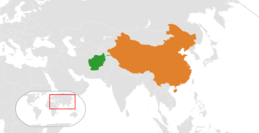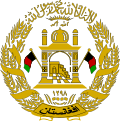Afghanistan–China relations
 | |
Afghanistan |
China |
|---|---|
Afghanistan – People's Republic of China relations were mostly warm and friendly during most of the 20th Century but after the Soviet invasion of Afghanistan in 1979, relations severely deteriorated. In the 21st century relations have improved significantly.
Historical relations
Throughout history, the relations between Afghanistan and China mostly involved trade of fruit and tea via caravans through Xinjiang and the Wakhan Corridor on the border between the two countries.[1]
Buddhist monks from the area of what is now Afghanistan were involved in the Silk Road transmission of Buddhism to Han dynasty China. The Han dynasty's Protectorate of the Western Regions bordered the Kushan Empire.
During the Tang dynasty parts of Afghanistan were under the control of China's Protectorate General to Pacify the West. In 659, Soghd and Ferghana, along with cities like Tashkent, Samarkand, Balkh, Herat, and Kabul, became part of the protectorate under Emperor Gaozong.[2] Afghanistan's Herat and Uzbekistan's Bukhara and Samarkand became part of the Tang protectorate.[3][4] The defeat of the Western Turks and the defeat of the Sassanids by the Arabs had facilitated the Chinese expansion under Emperor Gaozong into Herat, northeastern Iran and Afghanistan (Tukharistan), Bukhara, Samarkand, Tashkent, and Soghdiana, which previously belonged to the western Turks.[5]
Faxian traveled in Afghanistan.
Chinese Muslims fought against Japan in World War II. In order to gain backing for China in Muslim countries, Egypt, Syria, and Turkey was visited by Hui Muslim 馬賦良[6] Ma Fuliang and Uyghur Muslim Isa Yusuf Alptekin in 1939.[7] The Hindu leaders Tagore and Gandhi and Muslim Jinnah both discussed the war with the Chinese Muslim delegation under Ma Fuliang while in Turkey İsmet İnönü met with the Chinese Muslim delegation.[8] Newspapers in China reported the visit.[9] Ma Fuliang and Isa were working for Zhu Jiahua.[10]
The bombardment of Chinese Muslims by the warplanes of the Japanese was reported in the newspapers of Syria. Afghanistan, Iran, Iraq, Syria, and Lebanon were all toured by the delegation. The Foreign Minister, Prime Minister, and President of Turkey met with the Chinese Muslim delegation after they came via Egypt in May 1939. Gandhi and Jinnah met with the Hui Ma Fuliang and Uyghur Isa Alptekin as they denounced Japan.[11]
Modern relations
The People's Republic of China established diplomatic relations with the Kingdom of Afghanistan on January 20, 1955. Abdul Samad was the first Afghan Ambassador posted to Peking in 1955.
Premier Zhou Enlai and Vice Premier He Long visited Afghanistan in January 1957. This was the first ever visit taken by Chinese leadership to Afghanistan in the history of Sino-Afghan relations. During the visit, the Chinese Premier and Vice Premier met with King Mohammad Zahir Shah of Afghanistan, and held respective talks with Prime Minister Mohammad Daud Khan, Vice Prime Minister Ali Mohammad and Vice Prime Minister and Foreign Minister Mr. Mohammad Naim. The Chinese Premier's visit to Afghanistan enhanced mutual understanding between the two countries and laid a solid foundation for the development of friendly relations between China and Afghanistan. In October 1957, Prime Minister Mohammad Daud of Afghanistan visited China under China's invitation. During the visit, he held meetings with Chairman Mao Zedong, Vice Chairman Zhu De and Chairman Liu Shaoqi of the Standing Committee of the National People's Congress of China.
On November 22, 1963, China and Afghanistan signed in Beijing the Boundary Treaty between the People's Republic of China and the Kingdom of Afghanistan. This treaty settled the territorial dispute over the Afghan-controlled Wakhan on the border between Badakhshan Province in Afghanistan and the Xinjiang Uyghur Autonomous Region in China.[12] The China-Afghanistan border is 92.45 kilometers long.[13]
On December 27, 1979, Soviet troops were deployed in Afghanistan. On December 30, Chinese government made announcement condemning the Soviet military invasion, and refused to recognize the Soviet-backed Karmal government. The official relationship was stopped, and the Chinese embassy was degraded to representative office, and only dealt with consular and visa issues.[13]
During the Sino-Soviet split, strained relations between China and the USSR resulted in bloody border clashes and mutual backing for the opponent's enemies. China and Afghanistan had neutral relations with each other during the King's rule. When the pro-Soviet Afghan Communists seized power in Afghanistan in 1978, relations between China and the Afghan communists quickly turned hostile. The Afghan pro-Soviet communists supported China's then-enemy Vietnam and blamed China for supporting Afghan anticommunist militants. China responded to the Soviet war in Afghanistan by supporting the Afghan mujahideen and ramping up their military presence near Afghanistan in Xinjiang. China acquired military equipment from America to defend itself from Soviet attack.[14]
Military relations
The Chinese People's Liberation Army trained and supported the Afghan mujahideen during the war. The training camps were moved from Pakistan into China itself. Anti-aircraft missiles, rocket launchers and machine guns, valued at hundreds of millions, were given to the mujahideen by the Chinese. Chinese military advisors and army troops were present with the Mujahidin during training.[15]
The PLA trained and supported the Afghan mujahideen during the war, with training camps set up in Xinjiang, China. Anti-aircraft missiles, rocket launchers and machine guns, valued at hundreds of millions, were given to the mujahideen by the CCP. Chinese military advisors and army troops were present with the Islamists during training.[15] All this was done to undermine the Soviet Union's version of communism, and to prevent the USSR from attempting to encircle China.
In September 2018, Afghanistan's Ambassador to China, Janan Mosazai, announced that China will train Afghan soldiers in China, joining plane crews already training in China.[16]
Badakshan base
China is reportedly building a base for the Afghan Armed Forces in Badakhshan, with the goal of strengthening counter-terrorism cooperation.[17][18] Per General Dawlat Waziri of the Ministry of Defense, China will cover the base's material and technical expenses.[19][20]
Post-2001
After the fall of the Taliban regime after the United States intervention in 2001, relations between China and Afghanistan had greatly improved and were reestablished. In December 2001, China sent to Afghanistan a working team of the Ministry of Foreign Affairs, which attended the Afghan Interim Administration's foundation ceremony and sent a message of congratulations to President Hamid Karzai.
In January 2002, President Karzai visited China, and met respectively with Chinese President Jiang Zemin and Premier Zhu Rongji. The two sides exchanged the notes of China providing 30 million yuan of emergent material aid and US$1 million in cash to Afghanistan. President Jiang Zemin announced that China would provide US$150 million-worth of assistance to Afghanistan for its reconstruction. The 30 million yuan of emergent material aid had been delivered to Kabul by the end of March 2002. The Chinese Embassy in Afghanistan was reopened on February 6.
In May 2002, Chinese Foreign Minister Tang Jiaxuan visited Afghanistan. During the visit, the Chinese Foreign Minister met with Hamid Karzai, Chairman of the Interim Administration of Afghanistan and ex-King Zahir, and held talks with his counterpart Mr. Abdullah Abdullah. The two sides signed the Agreement on Economic and Technical Cooperation of US$30 million Chinese aid to Afghanistan. In November, Afghan Foreign Minister Abdullah Abdullah visited China. During his visit, the Chinese and Afghan sides exchanged the notes of China providing US$1 million of material aid to Afghanistan. In December, China, together with the other 5 neighboring countries of Afghanistan signed Kabul Declaration on Good Neighborly Relations, reaffirming its commitment to respect the sovereignty and territorial integrity of Afghanistan and to continuously support Afghanistan's peace process and reconstruction.
In February 2003, President Karzai passed through China twice. In May, the Vice President of Afghan Islamic Transitional Government Nematullah Sharhrani paid a working visit to China. During the visit he held talks with Chinese Vice President Zeng Qinghong and met with NPC Chairman Wu Bangguo and Premier Wen Jiabao. The two sides signed three cooperative documents including the Agreement of Economic and Technical Cooperation, under which the Chinese Government provides US$15 million grant to the Afghan Government.
Economics
Since 2010, China has increased its economic aid and investment in Afghanistan, notably with announcement by Metallurgical Corporation of China (MCC) pledging $3.5 billion to develop Aynak Copper mines.[21] China has the potential to make important contributions to Afghan stability. State-owned Chinese corporations are uniquely risk-tolerant and can help pave the way for future investments. The Chinese also enjoy a more positive relationship with Afghans, making their investments less likely to be targeted for attack by insurgents. These investments can stimulate economic growth that aid money alone cannot.
Bibliography
- Cardenal, Juan Pablo; Araújo, Heriberto (2011). La silenciosa conquista china (in Spanish). Barcelona: Crítica. pp. 81, 123.
See also
References
- ↑ electricpulp.com. "CHINESE-IRANIAN RELATIONS vi. Modern Afghan – Encyclopaedia Iranica". www.iranica.com. Retrieved 20 April 2018.
- ↑ Haywood, John; Jotischky, Andrew; McGlynn, Sean (1998). Historical Atlas of the Medieval World, AD 600-1492. Barnes & Noble. p. 3.20. ISBN 978-0-7607-1976-3.
- ↑ Harold Miles Tanner (13 March 2009). China: A History. Hackett Publishing. pp. 167–. ISBN 0-87220-915-6.
- ↑ Harold Miles Tanner (12 March 2010). China: A History: Volume 1: From Neolithic cultures through the Great Qing Empire 10,000 BCE–1799 CE. Hackett Publishing Company. pp. 167–. ISBN 978-1-60384-202-0.
- ↑ H. J. Van Derven (1 January 2000). Warfare in Chinese History. BRILL. pp. 122–. ISBN 90-04-11774-1.
- ↑ Hsiao-ting Lin (13 September 2010). Modern China's Ethnic Frontiers: A Journey to the West. Routledge. pp. 126–. ISBN 978-1-136-92393-7. http://wenku.baidu.com/view/b09c1314a8114431b90dd89a.html?re=view
- ↑ Hsiao-ting Lin (4 August 2010). Modern China's Ethnic Frontiers: A Journey to the West. Taylor & Francis. pp. 90–. ISBN 978-0-203-84497-7. Hsiao-ting Lin (13 September 2010). Modern China's Ethnic Frontiers: A Journey to the West. Routledge. pp. 90–. ISBN 978-1-136-92392-0. Hsiao-ting Lin (13 September 2010). Modern China's Ethnic Frontiers: A Journey to the West. Routledge. pp. 90–. ISBN 978-1-136-92393-7.
- ↑ "{title}". Archived from the original on 2016-09-19. Retrieved 2016-08-24.
- ↑ "歡迎艾沙馬賦良 暨近東各國新疆歸國學生 葉朱二氏昨舉行茶會 :: 民國38年前重要剪報資料庫". contentdm.lib.nccu.edu.tw. Retrieved 20 April 2018.
- ↑ "{title}". Archived from the original on 2016-05-13. Retrieved 2016-08-24.
- ↑ http://www.xzbu.com/7/view-1606508.htm
- ↑ International Boundary Study Afghanistan – China Boundary Archived 2015-01-03 at the Wayback Machine.
- 1 2 http://www.fmprc.gov.cn/chn//gxh/cgb/zcgmzysx/yz/1206/1206x1/t356107.htm
- ↑ S. Frederick Starriditor=S. Frederick Starr (2004). Xinjiang: China's Muslim Borderland (illustrated ed.). M.E. Sharpe. p. 157. ISBN 0-7656-1318-2. Retrieved May 22, 2012.
- 1 2 S. Frederick Starr (2004). Xinjiang: China's Muslim Borderland (illustrated ed.). M.E. Sharpe. p. 158. ISBN 0-7656-1318-2. Retrieved May 22, 2012.
- ↑ Reuters (September 6, 2018). "Afghan troops to train in China, ambassador says". The Straits Times.
- ↑ Kucera, Joshu (January 7, 2018). "Report: China Building Military Base on Afghan-Tajik Border". EurasiaNet. Retrieved January 8, 2018.
- ↑ "У границы с Таджикистаном появится новая военная база афганской армии" (in Russian). Ferghana Information Agency. January 3, 2018. Retrieved January 8, 2018.
- ↑ Aneja, Atul (January 10, 2018). "China to fund base in Afghanistan". The Hindu.
Fergana News Agency (FNA) has quoted Gen. Dawlat Waziri of the Afghan Defence Ministry as saying that China will provide financial support to build the base, whose precise location inside Badakshan, in northern Afghanistan, is yet to the determined. Gen. Waziri said that the Chinese side would cover all material and technical expenses for this base — weaponry, uniforms for soldiers, military equipment and everything else necessary for its functioning.
- ↑ Toktomushev, Kemel (January 18, 2018). "China's Military Base in Afghanistan". The Diplomat. Archived from the original on 2018-01-17. Retrieved 2018-01-17.
- ↑ http://carnegieendowment.org/files/china_role_afghanistan.pdf
.svg.png)
